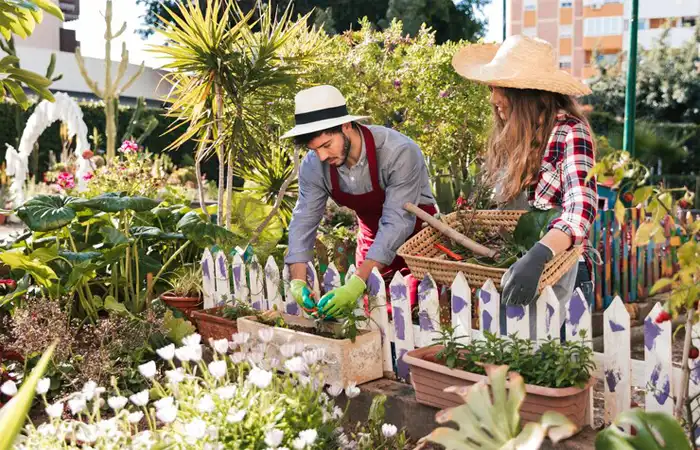
Blog
An Introduction to Gardening Begin Your Green Adventure Now

Starting a garden may be a fulfilling and healing activity that improves your environment, increases your connection to nature, and yields fresh vegetables. With these easy to follow techniques and tactics, you can go on your green adventure right now, regardless of the size of your yard or balcony..
Evaluate Your Area.
Recognize Your Growing Field
• sunshine Take note of the amount of sunshine that hits your garden. The majority of flowers and vegetables require six hours of sunshine every day.
• Soil Determine the kind of soil in your garden. Different soil types clay, sandy, or loamy have distinct qualities that affect whether plants will grow well in them.
• Space Ascertain how much room you have. With careful organization, even little spaces may be effective.
Select the Correct Plants.
Choose Easy to Grow Plants First
It is crucial to begin with plants that are simple to cultivate and care for for novices. Here are some recommendations:
• Vegetables Carrots, lettuce, radishes, and tomatoes are all fantastic options.
• Herbs Small areas may be used to cultivate beginner friendly herbs like basil,
• Flowers  Hardy plants like marigolds, sunflowers, and zinnias accentuate the attractiveness of your garden.
Think About Your Climate
Choose plants that are appropriate for the growth circumstances and climate in your area. Verify the hardiness zone for your region to be sure the plants you select will survive.
Assemble the necessary gardening tools.
Essential Tools for Novices
• Trowel For planting seeds or seedlings, use for excavating tiny holes.
Pruning shears Used for pruning plants and getting rid of overgrown or dead branches
• Garden Gloves Give your hands protection from blisters, thorns, and grime.
,br>• Watering Can or Hose Make sure your plants receive the necessary moisture.
• Garden Fork To eliminate weeds and loosen the soil.
Get Your Soil Ready.
Steps in Soil Preparation
• Test Your Soil To find out the pH and nutritional content of your soil, use a soil testing kit.
• Amend the Soil To increase soil fertility and structure, add compost, manure, or other organic matter in accordance with the findings of your soil test.
· Till the Soil Break up compacted soil and add fertilizers by using a garden fork or tiller.
Establishing a Garden.
Comparing seeds and seedlings
• Seeds Growing plants from seeds is more affordable and provides a greater range of plant options. For planting depth and spacing, refer to the directions on the seed packaging.
• Seedlings Purchasing immature plants, or seedlings, from a nursery will help you get started. Carefully transplant them into your garden.
Planting Methods
• Appropriate Spacing Make sure you allow adequate room for each plant to thrive. Plants that are overcrowded compete for resources and may get sick.
• Depth Make sure you sow seeds and seedlings at the proper depth. Either too deep or too shallow might impede development.
Upkeep and Watering.
Watering Tips
• Consistency Keep the soil constantly wet but not soggy. Rotten roots might result from overwatering.
• Watering in the morning Watering your plants early in the day minimizes evaporation and lets the leaves dry out, which lowers the chance of illness.
Mulching
To control soil temperature, weed growth, and moisture retention, mulch the area surrounding your plants. It is effective to use organic mulches like wood chips, straw, or grass clippings.
Pruning and Weeding
Weeds that compete with your plants for water and nutrients should be routinely removed. To promote healthy development, remove any dead or damaged plant portions via pruning.
Reaping and Sailing in Your Garden.
Tips for Harvesting
• Timing For the finest flavor and nutrients, harvest herbs and vegetables at their prime. Consult particular plant guides to determine the best times to harvest.
• instruments To chop or select your vegetables without harming the plants, use clean, sharp instruments.
Savoring Your Produce
Nothing compares to eating vegetables that has been cultivated locally. Cook with your herbs, prepare salads with your veggies, and arrange your flowers into lovely arrangements.
Recognize and Adjust.
Maintain a Gardening Diary
Keep a journal of your gardening endeavors, recording what succeeds and what fails. If you want to get better at gardening over time, keep track of planting dates, weather, and harvest periods.
Consult an Advisor
To exchange experiences and get guidance from seasoned gardeners, join neighborhood gardening clubs or online discussion boards. Ask inquiries and take in knowledge from others without fear.
In summary.
It may be a rewarding and delightful experience to begin gardening. You may easily create a successful garden by measuring your area, selecting the suitable plants, assembling necessary equipment, and according to planting and upkeep guidelines. Recall that gardening is an ongoing learning experience, so take your time, enjoy the process, and watch your garden flourish. Cheers to your successful gardening.
4 Comments
Leave a Reply














Noah
Thanks for the fantastic ideas!
James
Thanks for the great tips overall.
Charles
Keep up the great work!.
Marie Johnson
Thank you for the detailed tutorial and creative ideas!